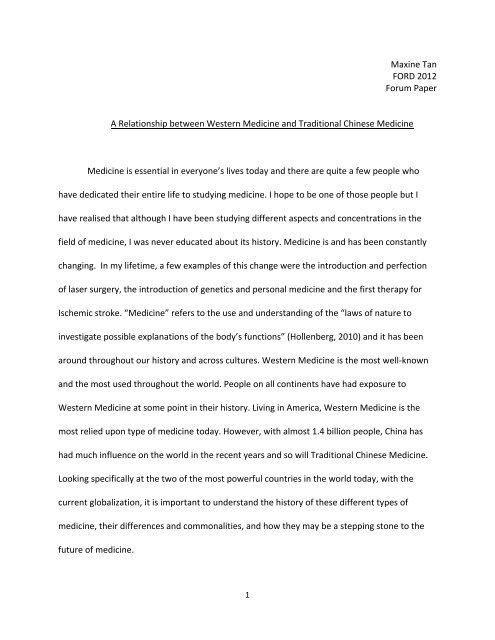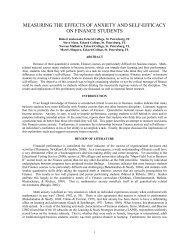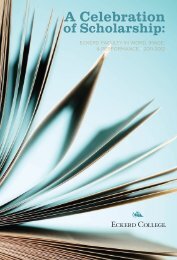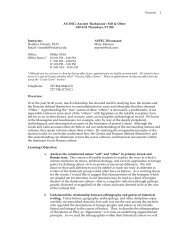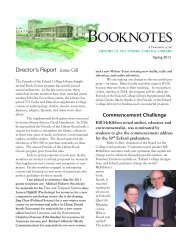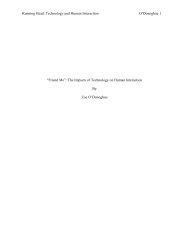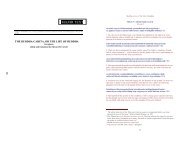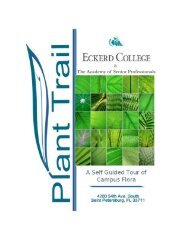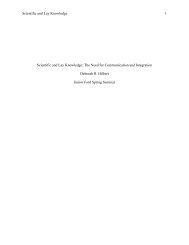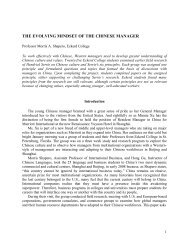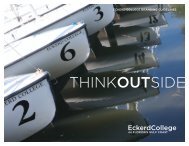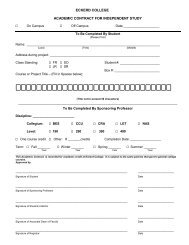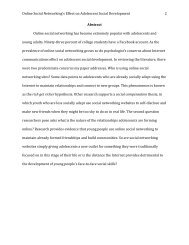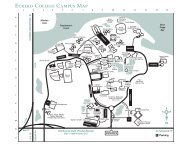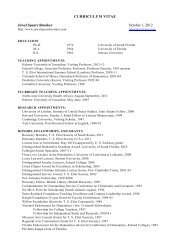A Relationship between Western Medicine and Traditional Chinese ...
A Relationship between Western Medicine and Traditional Chinese ...
A Relationship between Western Medicine and Traditional Chinese ...
You also want an ePaper? Increase the reach of your titles
YUMPU automatically turns print PDFs into web optimized ePapers that Google loves.
1<br />
Maxine Tan<br />
FORD 2012<br />
Forum Paper<br />
A <strong>Relationship</strong> <strong>between</strong> <strong>Western</strong> <strong>Medicine</strong> <strong>and</strong> <strong>Traditional</strong> <strong>Chinese</strong> <strong>Medicine</strong><br />
<strong>Medicine</strong> is essential in everyone’s lives today <strong>and</strong> there are quite a few people who<br />
have dedicated their entire life to studying medicine. I hope to be one of those people but I<br />
have realised that although I have been studying different aspects <strong>and</strong> concentrations in the<br />
field of medicine, I was never educated about its history. <strong>Medicine</strong> is <strong>and</strong> has been constantly<br />
changing. In my lifetime, a few examples of this change were the introduction <strong>and</strong> perfection<br />
of laser surgery, the introduction of genetics <strong>and</strong> personal medicine <strong>and</strong> the first therapy for<br />
Ischemic stroke. “<strong>Medicine</strong>” refers to the use <strong>and</strong> underst<strong>and</strong>ing of the “laws of nature to<br />
investigate possible explanations of the body’s functions” (Hollenberg, 2010) <strong>and</strong> it has been<br />
around throughout our history <strong>and</strong> across cultures. <strong>Western</strong> <strong>Medicine</strong> is the most well‐known<br />
<strong>and</strong> the most used throughout the world. People on all continents have had exposure to<br />
<strong>Western</strong> <strong>Medicine</strong> at some point in their history. Living in America, <strong>Western</strong> <strong>Medicine</strong> is the<br />
most relied upon type of medicine today. However, with almost 1.4 billion people, China has<br />
had much influence on the world in the recent years <strong>and</strong> so will <strong>Traditional</strong> <strong>Chinese</strong> <strong>Medicine</strong>.<br />
Looking specifically at the two of the most powerful countries in the world today, with the<br />
current globalization, it is important to underst<strong>and</strong> the history of these different types of<br />
medicine, their differences <strong>and</strong> commonalities, <strong>and</strong> how they may be a stepping stone to the<br />
future of medicine.
To underst<strong>and</strong> the principles <strong>and</strong> ideas that are unique to each type of medicine, its<br />
history must first be taken into consideration. <strong>Western</strong> <strong>Medicine</strong>, with its roots in the<br />
Mycenaean civilization has evolved significantly over the centuries <strong>and</strong> its history was very<br />
eloquently summarized by Lois Magner in 1992. In the Mycenaean period, 1500 to 1100BC,<br />
there was a shift away from the belief that Gods were the cause of disease <strong>and</strong> plagues to<br />
Empedocles’ idea that “all things were composed of various mixtures of four primary <strong>and</strong><br />
eternal elements: air, earth, water, <strong>and</strong> fire” (Magner, pg66). The idea that disease <strong>and</strong> illness<br />
were not supernatural <strong>and</strong> could be explained through reason <strong>and</strong> logic sparked the field of<br />
<strong>Western</strong> <strong>Medicine</strong> as we know it today. 700<br />
years later, Hippocratic medicine developed<br />
<strong>and</strong> was the foundation of <strong>Western</strong><br />
<strong>Medicine</strong>. It emphasized the idea of “at least<br />
do no harm” in addition to “the patient<br />
instead of the disease, observation rather<br />
than theory, [<strong>and</strong>] respect for facts <strong>and</strong><br />
experience rather than philosophical systems”,<br />
2<br />
Figure 1: Four Humours <strong>and</strong> Four temperaments.<br />
<strong>and</strong> http://intraspec.ca/images/4humors2.png<br />
(Magner, pg68) Hippocrates also thought that health was the result of a balance of the four<br />
humours which corresponded to the four elements (Figure 1). Around 50AD, during the Roman<br />
Empire, Dioscorides discovered <strong>and</strong> compiled medicinal herbs <strong>and</strong> was the first <strong>Western</strong>
herbalist. The ideas of Hippocrates <strong>and</strong> Dioscorides were analysed in the 2 nd century by Galen,<br />
who was most influential in the “concepts of anatomy, physiology, therapeutics <strong>and</strong> philosophy”<br />
(Magner, pg87). Galen believed that medicine <strong>and</strong><br />
philosophy worked h<strong>and</strong> in h<strong>and</strong> as a “true physician<br />
must master the three branches of philosophy: logic,<br />
the science of how to think, physics, the science of<br />
nature, <strong>and</strong> ethics, the science of what to do” (Magner,<br />
pg89). He further developed Hippocrates doctrine by<br />
associating four temperaments or qualities (warm,<br />
cold, moist or dry) <strong>and</strong> their combinations to the four<br />
humours (Figure 1). In addition, Galen exp<strong>and</strong>ed upon<br />
Dioscorides work to create complex concoctions <strong>and</strong><br />
simple medicines, thus initiating the development of<br />
drugs.<br />
However, tradition was eventually replaced by<br />
3<br />
Figure 2: Leonardo Da Vinci’s scientific<br />
Sketches depicting the detail <strong>and</strong><br />
muscle function of the human arm.<br />
http://library.thinkquest.org/3044/gall<br />
ery/sc62.gif<br />
science which developed <strong>Western</strong> <strong>Medicine</strong> into what it is today. Throughout the Renaissance<br />
(1450 to 1700), the idea of <strong>Western</strong> medicine was altered under the influence of three people,<br />
Leonardo Da Vinci, Vesalius <strong>and</strong> Paracelsus. Da Vinci combined art, anatomy <strong>and</strong> mathematics<br />
to study the mechanical functions of the skeleton (Figure 2). Vesalius also studied anatomy<br />
specifically of “the structure of the heart, arteries <strong>and</strong> veins providing anatomical research that<br />
has been a cornerstone of <strong>Western</strong> <strong>Medicine</strong>” (Magner, pg163) while Paracelsus “developed a<br />
system based on analogies to chemical processes” which led to the fields of pharmacology,
diagnostics <strong>and</strong> therapeutics today (Magner, pg 172)(Magner, 1992). The Scientific Revolution<br />
of the 17 th century also provided new discoveries in the field of medicine with William Harvey’s<br />
underst<strong>and</strong>ing of the circulation of blood <strong>and</strong> later Edward Jenner’s introduction of vaccines as<br />
a preventive measure against smallpox <strong>and</strong> cow pox. Finally in the 19 th century, Louis Pasteur’s<br />
idea of microscopic cells called bacteria along with technological advances developed <strong>Western</strong><br />
<strong>Medicine</strong> into the field it is today. (Magner, 1992)<br />
The history of <strong>Traditional</strong> <strong>Chinese</strong> <strong>Medicine</strong> on the other h<strong>and</strong> is not as linear <strong>and</strong> clear<br />
cut, developing out of myth into history. This history of <strong>Traditional</strong> <strong>Chinese</strong> <strong>Medicine</strong> <strong>and</strong> most<br />
of the theories <strong>and</strong> ideas that are part of current medicine can be summarized by two works,<br />
the Yellow Emperor’s Classic of the Internal <strong>Medicine</strong> <strong>and</strong> Shen Nong’s Classic of Hernal<br />
<strong>Medicine</strong>, both of which were compiled in the Han Dynasty in the 3 rd century (Hoizey & Hoizey,<br />
1993). In the stories passed down through generations, it was said that the Yellow Emperor <strong>and</strong><br />
Shen Nong were collaborators even though they were 17 generations apart from each other.<br />
Shen Nong, who is believed to have lived in the 25 th century BC, was also known as the “Divine<br />
Cultivator” <strong>and</strong> the founder of herbal medicine("Basic Principles", 2009). Later, with the<br />
development of the ideas of Confucianism, around 500BC, the Yellow Emperor incorporated<br />
this into his underst<strong>and</strong>ing of medicine <strong>and</strong> these principles are still what current <strong>Traditional</strong><br />
<strong>Chinese</strong> <strong>Medicine</strong> is based on.<br />
Confucianism mainly focuses on the ability for humans to strive for altruism,<br />
righteousness <strong>and</strong> appropriate conduct. There are three basic principles of Confucianism that<br />
have become the three main principles in <strong>Traditional</strong> <strong>Chinese</strong> <strong>Medicine</strong>, one of which is the<br />
theory of Yin <strong>and</strong> Yang. The Yin <strong>and</strong> Yang theory, which is used to underst<strong>and</strong> relationships<br />
4
within the body, is one that illustrates balance <strong>between</strong> parts <strong>and</strong> how a part in relation to the<br />
whole. This theory also emphasizes that Yin <strong>and</strong> Yang can oppose each other, depend on each<br />
other <strong>and</strong> transform into each other ("Basic Principles", 2009). Another idea that plays a main<br />
role is <strong>Traditional</strong> <strong>Chinese</strong> <strong>Medicine</strong> are the five elements, wood, fire, earth, metal <strong>and</strong> water.<br />
The close relationships that these elements have with Yin <strong>and</strong> Yang, nature <strong>and</strong> the body can be<br />
summarized in Table 1. In addition to the theories, there is also the belief in Qi, the most<br />
fundamental “life energy” flowing throughout our body that is necessary for life ("Basic<br />
Principles", 2009). It is when Qi flow is disrupted or blocked that people get sick <strong>and</strong>/or die,<br />
thus, <strong>Traditional</strong> <strong>Chinese</strong> <strong>Medicine</strong> main goal is to maintain <strong>and</strong> restore the flow of Qi.<br />
Table 1: The relationship <strong>between</strong> Yin <strong>and</strong> Yang, the 5 Elements <strong>and</strong> Organs<br />
According to Hoizey & Hoizey (2003), <strong>Traditional</strong> <strong>Chinese</strong> <strong>Medicine</strong> was also influenced<br />
by a few other factors during the Three Kingdoms in the 5 th century. <strong>Medicine</strong>, manufactured<br />
by Daoism alchemy during this time period, was the first <strong>Chinese</strong> pharmacy while acupuncture<br />
became famous in 200AD with the publication of the book The ABC of Acupuncture <strong>and</strong><br />
5
Moxibustion. Another publication was Emergency Prescriptions by Ge Hong which allowed for<br />
practical <strong>and</strong> effective remedies <strong>and</strong> advances in <strong>Traditional</strong> <strong>Chinese</strong> <strong>Medicine</strong> to be cheap <strong>and</strong><br />
easily accessible to the general public. In the 1700s, <strong>Chinese</strong> were exposed to <strong>Western</strong><br />
<strong>Medicine</strong> for the first time <strong>and</strong> Mao, in 1958, increased further integration of East <strong>and</strong> West<br />
<strong>Medicine</strong> as part of his vision for the Cultural Revolution. (Hoizey & Hoizey, 1993)<br />
With the development of these two types of medicine across time <strong>and</strong> culture, it is<br />
expected that there would be fundamental differences <strong>between</strong> the two paradigms. Tao (2011)<br />
states the most obvious difference as the basic hypotheses that these two paradigms are based<br />
on modern science <strong>and</strong> the balance of Yin <strong>and</strong> Ying. <strong>Western</strong> <strong>Medicine</strong> focuses on the different<br />
fields of science looking at the body in parts <strong>and</strong> sections relatively independent of each other<br />
while <strong>Traditional</strong> <strong>Chinese</strong> <strong>Medicine</strong> is about balance <strong>and</strong> “determining treatment by identified<br />
patterns based on an overall analysis” (Tao, 2011). The underst<strong>and</strong>ing also differs significantly.<br />
<strong>Western</strong> <strong>Medicine</strong> focuses on all the detailed<br />
anatomy of the human body emphasized<br />
through Leonardo Da Vinci’s work (Figure 2).<br />
However, <strong>Traditional</strong> <strong>Chinese</strong> <strong>Medicine</strong><br />
underst<strong>and</strong>s the human body based on the<br />
function of a structure <strong>and</strong> often overlooks<br />
the need for an underst<strong>and</strong>ing of concrete<br />
details (Tao, 2011), represented by Figure 3<br />
("Basic Principles", 2009). Furthermore,<br />
<strong>Western</strong> <strong>Medicine</strong> is a science <strong>and</strong> can be<br />
6<br />
Figure 3: Anatomy from a <strong>Traditional</strong> <strong>Chinese</strong><br />
<strong>Medicine</strong> point of view.
thought to be a scientific experiment, verifying <strong>and</strong> testing a hypothesis; there is a systematic<br />
approach. On the other h<strong>and</strong>, <strong>Traditional</strong> <strong>Chinese</strong> <strong>Medicine</strong> depends more on feeling <strong>and</strong><br />
experience <strong>and</strong> its goal is “not to explore the unknown world but to confirm our ancestors’<br />
conclusions” (Tao, 2011). This idea of <strong>Traditional</strong> <strong>Chinese</strong> <strong>Medicine</strong> is supported by its history<br />
with little new discovery over the course of 4500 years. Hence, these two types of medicine do<br />
not appear to have the ability to be integrated as their fundamental ideas on which the entire<br />
system is based is so drastically different.<br />
Yet, there are small similarities <strong>between</strong> West <strong>and</strong> East. Since there are many branches<br />
to medicine, each with unique differences, the similarities <strong>between</strong> <strong>Western</strong> <strong>and</strong> Eastern<br />
herbalism will be used to illustrate how similar these two types of medicine can be. Herbalism<br />
was developed very early in both histories of medicine <strong>and</strong> thus, should be the least similar due<br />
to an inability for cultures to influence each other through contact. There are three main<br />
principles of <strong>Western</strong> herbal medicine, energetics, organ systems <strong>and</strong> the government of<br />
circulation(Wood, 2010). Energetics in <strong>Western</strong> <strong>Medicine</strong> was initially developed by Galen from<br />
Hippocrates doctrine, associating four temperaments<br />
to the four humours (Figure 1). This is similar to the<br />
“Six Doors <strong>and</strong> Three Methods” that Zhang Congzheng<br />
added to <strong>Traditional</strong> <strong>Chinese</strong> <strong>Medicine</strong> in 1200 (Hoizey<br />
& Hoizey, 1993). These six doors were wind, heat,<br />
dampness, fire, dryness <strong>and</strong> cold which could be<br />
derived from the three methods, the heavens, the<br />
earth <strong>and</strong> man’s behaviour (Hoizey & Hoizey, 1993).<br />
7<br />
Figure 4: Location of pathogenic<br />
effects of the “Six Doors”.
These would attack different parts of the body (Figure 4) <strong>and</strong> weaken the protective Qi of the<br />
person. It is shown that the essential theory of the introduction of illness in herbalism is similar;<br />
however, it is associated with Qi <strong>and</strong> Three Methods in <strong>Traditional</strong> <strong>Chinese</strong> <strong>Medicine</strong> causing it<br />
to start to differ.<br />
The second similarity was organ systems which <strong>Western</strong> herbalism would be treated as<br />
systems, where parts are viewed in terms of the whole <strong>and</strong> are treated with herbs based on its<br />
general function (Wood, 2010). This is similar to the fundamental principle of Yin <strong>and</strong> Yang in<br />
<strong>Traditional</strong> <strong>Chinese</strong> <strong>Medicine</strong>. Specifically for organs in <strong>Traditional</strong> <strong>Chinese</strong> <strong>Medicine</strong>, organs are<br />
associated with either Yin of Yang based on their function (Table 1) <strong>and</strong> illness would be treated<br />
as an imbalance in the entire system. However, not all <strong>Western</strong> <strong>Medicine</strong> has similar principles<br />
to herbalism which may lead to drastic difference in the method <strong>and</strong> approach of treatment<br />
<strong>between</strong> types of medicine.<br />
The third similarity was the government of circulation. In <strong>Western</strong> <strong>Medicine</strong>, circulation<br />
is generally understood as governed from the inside out as the temperature of extremities<br />
fluctuate with the circulation of blood while important organs in the core are protected from<br />
the harsh external environments. Galen in <strong>Western</strong> herbalism “classified herbs according to<br />
whether they opened, closed, moved up or down, thinned or thickened” (Wood, 2010). This is<br />
similar to that of the movement of Qi throughout the body where Qi moved in four directions,<br />
up, down, outward <strong>and</strong> inward. However, unlike blood, the distribution network of Qi is<br />
through the Meridian System initially described in The Yellow Emperor’s Classic of Internal<br />
<strong>Medicine</strong> ("Basic Principles", 2009). This system is not based on vessels but rather on the 365<br />
acupuncture points throughout the body, forming meridian channels connecting important<br />
8
organs (Risse, 1973). Thus, even though there are still differences in the fundamental ideas<br />
around which each type of medicine revolves around, looking at <strong>Western</strong> herbalism shows that<br />
there is some overlap in ideas <strong>and</strong> that in terms of herbalism, it would be possible to integrate<br />
West <strong>and</strong> East to some extent which may not be true for other branches of <strong>Western</strong> <strong>Medicine</strong>.<br />
However, these small similarities may prove to be a stepping stone that would allow for<br />
the advancement of the field of medicine as a whole especially in terms of the new field of<br />
natural products. Natural products are defined as the use of naturally produced substances for<br />
medicinal purposes. These products can be used directly as in herbalism, isolated from<br />
organisms through isotopic labelling studies or more recently, through genetic engineering. In<br />
this field, I believe that <strong>Western</strong> <strong>Medicine</strong> provides the foundation of technology <strong>and</strong> scientific<br />
methodology for the discovery of these products while <strong>Traditional</strong> <strong>Chinese</strong> <strong>Medicine</strong> would<br />
provide the knowledge base <strong>and</strong> novel ideas to <strong>Western</strong> culture to support this research. An<br />
example of this already occurring is shown through Sertel et al (2010) research in Germany,<br />
where plants used in <strong>Traditional</strong> <strong>Chinese</strong> <strong>Medicine</strong> were found to also be novel epidermal<br />
growth factor receptor inhibitors involved in cancer therapy.<br />
Keeping these new possibilities for future research in mind along we knowledge of the<br />
history of both paradigms of medicine, the importance of the integration of <strong>Western</strong> <strong>and</strong><br />
Eastern medicine is highlighted. I believe that to be fully educated in your field of interest <strong>and</strong><br />
be able to make significant contributions to your field, it is essential to underst<strong>and</strong> <strong>and</strong> learn<br />
about the history of your field while making connections with present day technology amd<br />
ideas. <strong>Western</strong> <strong>Medicine</strong> has a very well developed linear history, based on ideas from different<br />
branches of medicine, concrete details <strong>and</strong> the scientific method; whereas <strong>Traditional</strong> <strong>Chinese</strong><br />
9
<strong>Medicine</strong> has a longer history initially developing from myths <strong>and</strong> stories <strong>and</strong> based on<br />
Confucianism, Yin <strong>and</strong> Yang <strong>and</strong> Qi. However, these seemingly different types of medicine,<br />
which are based on different theories, have similarities in herbalism such as energetics, organ<br />
systems <strong>and</strong> the government of circulation. If these areas of similarities are discovered <strong>and</strong><br />
exp<strong>and</strong>ed upon, this may be a stepping stone for future work in medicine such as the young,<br />
rapidly exp<strong>and</strong>ing research in natural product discovery.<br />
10
References:<br />
"Basic Principles". (2009). <strong>Traditional</strong> <strong>Chinese</strong> <strong>Medicine</strong> Retrieved April 3, 2012, from<br />
http://www.shen‐nong.com/eng/front/index.html<br />
Hoizey, D., & Hoizey, M.‐J. (1993). A history of <strong>Chinese</strong> medicine / Dominique <strong>and</strong> Marie‐Joseph<br />
Hoizey ; translated by Paul Bailey: Vancouver, BC : UBC Press, c1993.<br />
Hollenberg, D. (2010). What Is <strong>Medicine</strong>?: <strong>Western</strong> <strong>and</strong> Eastern Approaches to Healing [Book<br />
Review]. Health Sociology Review: The Journal of the Health Section of the Australian<br />
Sociological Association, 19(3), 395.<br />
Magner, L. N. (1992). A history of medicine / Lois N. Magner: New York : M. Dekker, c1992.<br />
Risse, G. B. (1973). Modern China <strong>and</strong> traditional <strong>Chinese</strong> medicine; a symposium held at the<br />
University of Wisconsin, Madison. Edited by Guenter B. Risse: Springfield, Ill., Thomas<br />
[1973].<br />
Sertel, S., Plinkert, P., & Efferth, T. (2010). Natural products derived from traditional chinese<br />
medicine as novel inhibitors of the epidermal growth factor receptor.<br />
Combinatorial Chemistry & High Throughput Screening, 13(10), 849‐854.<br />
Tao, L. (2011). Philosophic Perspective: A Comparative Study of <strong>Traditional</strong> <strong>Chinese</strong> <strong>Medicine</strong><br />
<strong>and</strong> <strong>Western</strong> <strong>Medicine</strong>. Asian Social Science, 7(2), 198.<br />
Wood, M. (2010). The Three Basic Principles of <strong>Traditional</strong> <strong>Western</strong> Herbalism Retrieved April<br />
3rd, 2012, from http://www.naturasophia.com/Principles.html<br />
11


